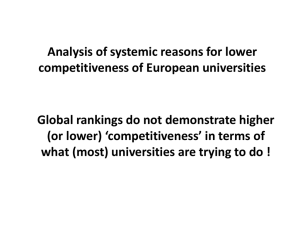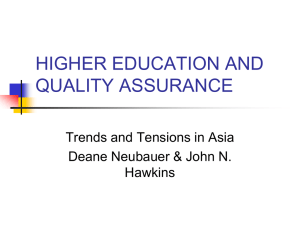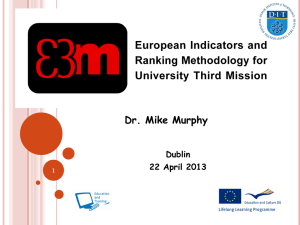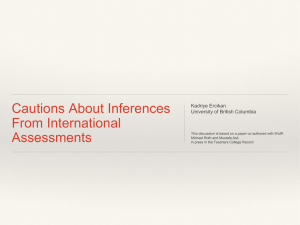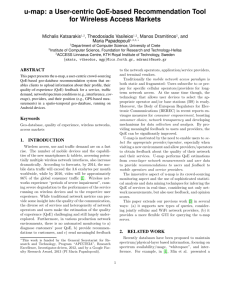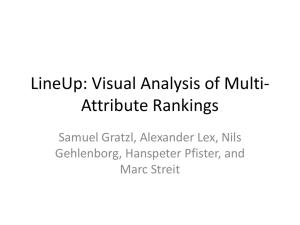Mapping and Ranking - Council for Higher Education Accreditation
advertisement
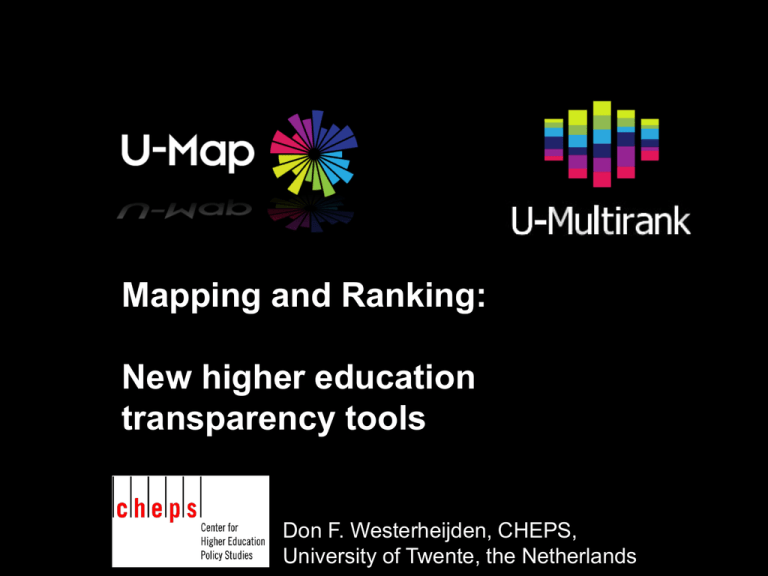
• N Mapping and Ranking: New higher education transparency tools Don F. Westerheijden, CHEPS, University of Twente, the Netherlands Diversity in Higher Education Systems • Diversity and differentiation • Institutional and programme diversity • Horizontal and vertical diversity Diversity in Higher Education Systems • Offers better access to a wider variety of students • Provides more social mobility through multiple modes of entry and forms of transfer • Better meets the diverse needs of the labor market • Is a condition for regional specialisation • Serves the political needs of larger number of interest groups (social stability) • Increases the effectiveness of higher education institutions (institutional specialisation) • Offers opportunities for experimentation The rise of global rankings • Academic Ranking of World Class Universities (ARWU) Shanghai Jiaotong University, since 2003 • Times Higher Education Supplement World Rankings (THE) Times Higher Education, since 2004 • Higher Education Evaluation and Accreditation Council of Taiwan Ranking (HEEACT), since 2007 • The Leiden Ranking (LR) Leiden University, since 2008 Critique of existing rankings • • • • • • • Focus on ‘whole institutions’ (ignoring internal variance) Concentrate on ‘traditional’ research productivity and impact Focus on ‘comprehensive research universities’ Aggregate performance into composite overall indicators Use constructed ‘league table’ Imply cultural and language biases Imply bias against humanities and social sciences Designing an alternative: the EC Call for Tender (2009) • Development of concept and feasibility study • Global ranking (not only European) • Multi-dimensional - teaching and learning (incl. employability) - research - knowledge transfer - internationalisation (incl. mobility) - community outreach • Institutional and field-based (disciplines) • All types of higher education and research institutions • Multiple stakeholders Project partners Center for Higher Education Development (CHE) www.che.de Center for Higher Education Policy Studies (CHEPS) www.utwente.nl/cheps Centre for Science and Technology Studies (CWTS) www.cwts.nl International Centre for Research on Entrepreneurship, Technology and Innovation Management (INCENTIM) www.incentim.com Observatoire des Sciences et des Techniques (OST) European Foundation for Management Development (EFMD) European Federation of National Engineering Associations (FEANI) www.obs-ost.fr www.efmd.org www.feani.org Conceptual approach • One common ranking of all higher education and research institutions worldwide does not make sense for any group of stakeholders • Identify institutions that are comparable • Use the U-Map classification tool to find comparable ‘institutional profiles’ • Apply ranking instrument to sets of comparable institutions or fields Classifications in Higher Education • Instruments to group higher education institutions • And to characterize similarities and differences • Based on the actual conditions and activities of institutions Functions of Classifications • • • • • Transparency tool (various stakeholders) Instrument for institutional strategies (mission, profile) Base for governmental policies Tool for research Instrument for better ranking US Carnegie Classification • • • • • Initial objective (1973): improve higher education research Over time several adaptations: 1976, 1994, 2000, 2006 Labels and categories Impacts on higher education system dynamics Multi-dimensional approach (2006) European Classification: U-Map • Recently designed; three reports (2005, 2008, 2010); book (2009) • Interactive design process (stakeholders approach) • Basic design principles • Tested on validity, reliability, feasibility • 2010-2011: filling with real data is starting • See: www.u-map.eu Design Principles U-Map is: • based on empirical data • based on a multi-actor and multi-dimensional perspective • non-hierarchical • relevant for all higher education institutions in Europe • descriptive, not prescriptive • based on reliable and verifiable data • parsimonious regarding extra data collection U-Map dimensions 1. 2. 3. 4. 5. 6. Teaching and learning profile Student profile Research involvement Knowledge exchange International orientation Regional engagement Institutional Profiles Institutional Profiles • • • • • • Sets of ‘scores’ on the dimensions and indicators Actual institutional activities, not performance Full or partial institutional profiles Information for external stakeholders Instrument for strategic institutional management Base for benchmarking, for inter-institutional cooperation, for effective communication and profiling U-Map website www.u-map.eu U-Multirank Design principles • • • • Multidimensional Multilevel Comparing comparable institutional profiles Stakeholder driven U-Multirank Dimensions • • • • • Teaching and learning Research Knowledge transfer International orientation Regional engagement U-Multirank Logic of institutional rankings descriptive institutional profiles on six dimensions performance profiles of each dimension, no aggregated institutional rankings to be called: Focused Institutional Rankings Pilots focused institutional rankings (150 HEIs) U-Map Profile Finder Subset of comparable institutions (A, B, C, D) Subset of comparable institutions (E, F, G, C) Stakeholders Main stakeholders: National policy makers Main stakeholders: HEIs/HEI managers Teaching & learning Research Dimensions Knowledge exchange Internationalisation Regional engagement A A A A A B C D B C D B C D D B B D E E E E E F G C F G C F G C F G F G U-Multirank Logic of field-based rankings descriptive institutional profiles on six dimensions performance profiles of specific field in institutions with comparable profiles to be called: Field-based Rankings Pilots field-based rankings Fields Businessstudies Engineerin g U-Map Profile Finder subset of comparable HEIs (example: many MA, internationally oriented, research intens.) subset of comparable HEIs (example: regionally oriented, innovation-oriented, many BA) Stakeholders MA/PhD students HEIs/HEI managers Teaching & learning Research Dimensions Knowledge exchange Internationalisation Regional engagement A A A A A B C D B C D B C D D B B D E E E E E F G C F G C F G C F G F G U-Multirank ‘multiple excellences’ • • • • • Multidimensional perspective of ‘institutional profiles’ No overall ‘league tables’ No composite institutional indicators Two-level analysis (institutional and ‘field’) Stakeholder-driven approach U-Multirank 2010-2011 Feasibility study • Identification and selection of relevant indicators per dimension • Pre-test of instruments (10 institutions) • Two-level pilot test (150 institutions worldwide) U-Multirank Indicators Teaching and Learning Focused Institutional Field based • • • • • • • • • • • Graduation rate Relative employment rate Expenditure on teaching Time to degree interdisciplinarity Student staff ratio Relative employment rate Graduation rate Quality of staff Interdisciplinarity Student satisfaction scores U-Multirank Indicators Research Focused Institutional Field based • • • • • • External research incme • Research publ output • Stud satisfaction: research orientation of programmes • Citation impact • Doctoral productivity Research publ output Expenditure on research Citation impact Highly cited publications Research income from competitive sources U-Multirank Indicators Knowledge transfer Focused Institutional • Size of TTO • Incentives for knowledge exchange activities • Joint research contracts with private sector • Patents • Third party funding Field based • Ac staff with experience outside higher education • Joint research contracts with private sector • Patents • Spin-offs U-Multirank Indicators International orientation Focused Institutional Field based • Programmes in foreign language • Internat academic staff • Joint degree programmes • Internat joint research publications • Internat partnerships • % internat students • Mobile students • Stud sat.: opportunity to stay abroad • Internat academic staff • Internationalisation of programmes • Joint international projects U-Multirank Indicators Regional engagement Focused Institutional Field based • Income from regional/local sources • Graduates working in the region • Joint R&D with regional enterprises • Stud internships in region • Stud internships in region • Joint R&D with regional enterprises • Regional intake of students • Graduates working in the region • Courses for sec ed students • Regional part in cont. ed U-Multirank Pretest Three instruments Institutional questionnaire Departmental questionnaire Student questionnaire U-Multirank Pretest Pre-test results 9 institutions (three full version; six light version) Indicators dropped Indicators amended U-Multirank Pilot Current phase 150 institutions, across all continents A few more US universities would be welcome! Focus on feasibility analyses Starting October 2010, ending Spring 2011 U-Map Publications • F.A. van Vught, F. Kaiser a.o. (2010) U-Map, the European classification of higher education institutions, CHEPS, Enschede • F.A. van Vught (ed.) (2009), Mapping the higher education landscape, Towards a European classification of higher education, Springer U-Multirank Publications • CHERPA-Network (2009) U-Multirank Interim Progress Report I, Design Phase of the Project ‘Design and Testing the Feasibility of a Multi-dimensional Global University Ranking’ • CHERPA-Network (2010) U-Multirank Interim Report II, Selection of instruments and institutions Thank you for your attention! www.u-map.eu www.u-multirank.eu d.f.westerheijden@utwente.nl

